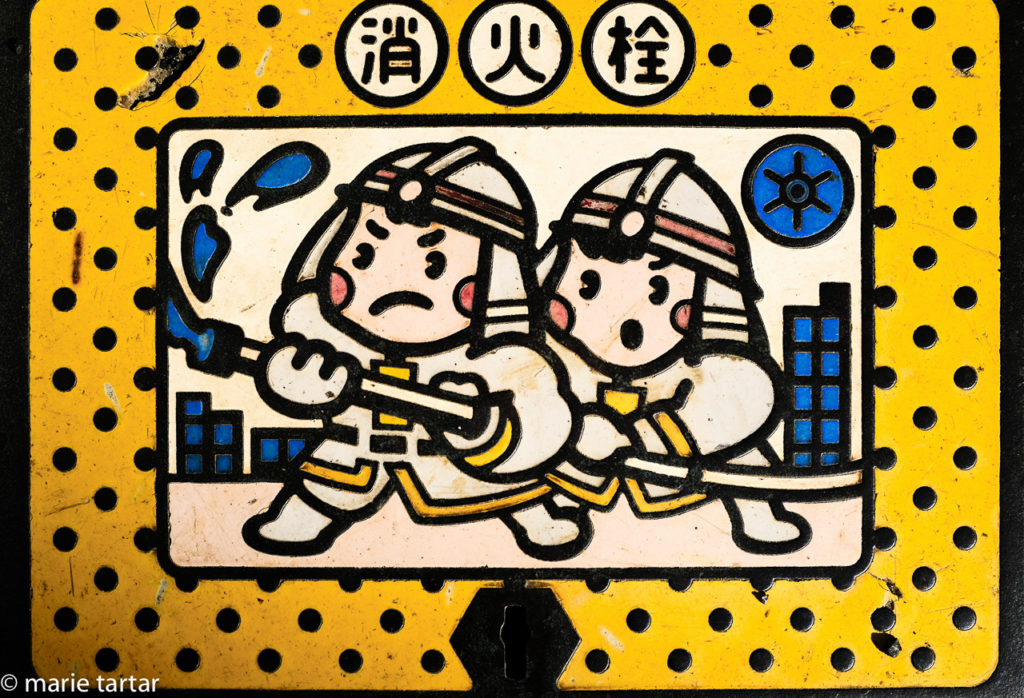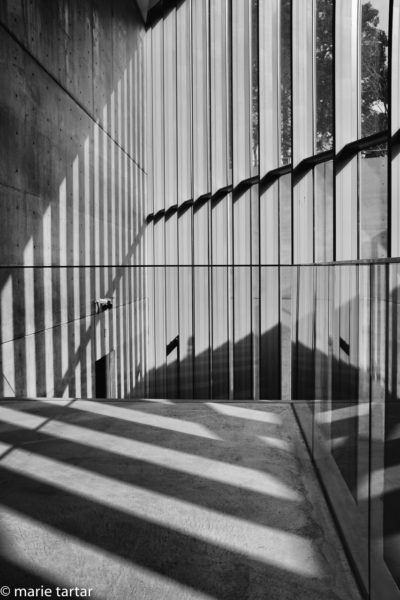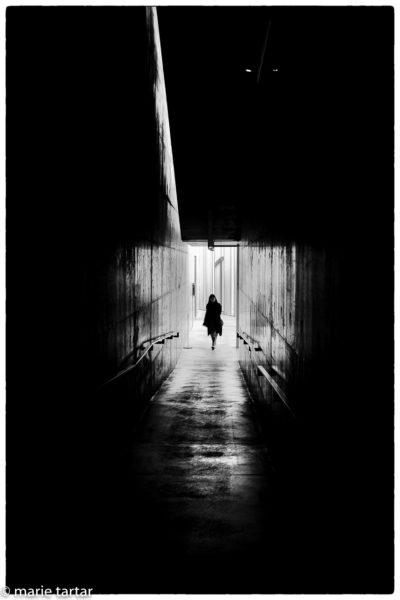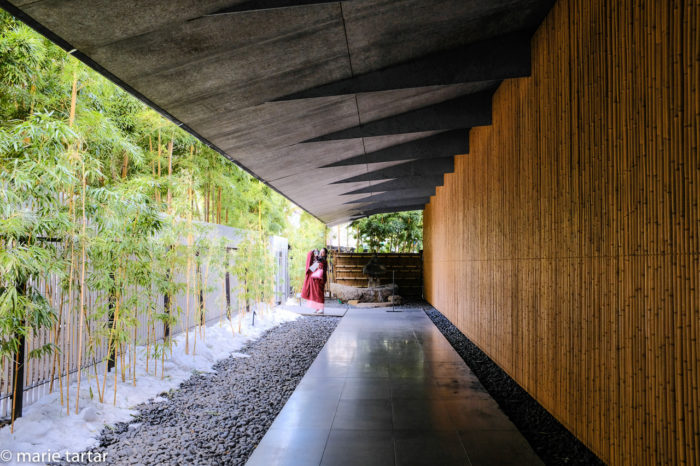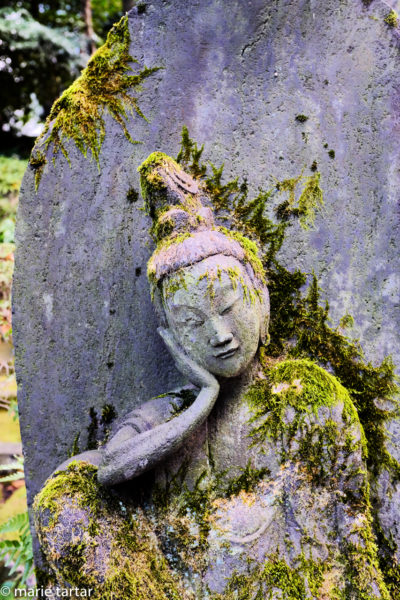
To paraphrase Dickens, it was the best of trips, it was the worst of trips. We love Japan, so much that this was our 7th trip. We’d never been in winter and were eager to see a different, natural and wild side, namely snowy landscapes and wildlife.
Snow monkeys steaming in hot springs and photographer artist Michael Kenna’s minimalist Hokkaido winter landscapes were major motivators for us to sign up for a small group winter photographic trip to Japan with Jack Graham Photo Workshops. Steve, Greg and I knew Jack from one prior workshop in Northern Arizona and Navajoland, back in April, 2015. Priced at $6500 and billed as only 5 participants and 2 guides, it immediately caught my attention. The co-trip leader, Susan Myers, was purported to be a bird expert, as well as fluent in Japanese.
Saturday, January 27, 2018
Our way east was eased by premium economy United bulkhead seats. I whiled away the time with a film festival slate of 4, starting with a hilarious Japanese comedy called (in English), What a Wonderful Family! 2. Chatting with my friend Mari in Tokyo later, she recognized it as Family is a Pain in the Neck. Directed by Yoji Yamada, this was a very smart and sharply funny family comedy of aging. Family patriarch Shuzo keeps bashing up his car. His adult children are determined to curtail his driving, but he is equally bent on maintaining his freedom.
Shuzo and his wife live in a 3 generation household, with his oldest son, his wife and their 2 sons, not an unusual arrangement in Japan. His wife wants to see the aurora borealis before she dies and is on her way to Tromso, Norway, through which we passed on our Northern Lights focused trip to Lofoten, Norway in September.
This film had multiple funny parallels for me personally, coming on the heels of a long weekend in DFW helping 81-year-old Mama with house repairs and clean-up and beginning estate planning.
My second film was Wonder Woman, a fun kick-ass girl power super-heroine film, directed by Patty Jenkins. Gorgeous Gal Gadot rocked as Diana, who leaves her idyllic home to help humanity battle the Nazis.
To Each His Own was an interesting, touching Japanese film meditation on the meaning of work, that is, what we work for. A young salesman is ground down by his job. Driven to the point of exhaustion one night, he almost falls in front of a train. He is saved by his old school friend, Yamamoto, who is lively and relaxed, the precise opposite of the despairing salaryman in training.
My final film was a French film, Chateau, highlighting hustling young men from Africa who try to steer clients into hair salons near Chateau d’Est in the outskirts of Paris. This was an interesting look at a slice of Parisian life on the outskirts.
Sunday, January 28, 2018
We intersected with Greg without difficulty in Narita, two nights ahead of the workshop’s start. I had booked us an apartment in Roppongi, our first time to use AirBnB. The electronic house manual was many pages long, and the instructions for finding the place daunting enough that Greg had texted me before departure:
“The map you sent for how to get to the apartment broke my Enigma machine.”
Since we were arriving within an hour of each other, I suggested he wait for us and we’d all go together via the Narita Express train to Tokyo station and then cab it to the apartment.
The tonkatsu (pork cutlet) palace, Tonki, was only 3 stops away by subway. Of course, there was a line of hungry diners, but soon enough, we had a front row seat at the large U-shaped bar and an unobstructed view of the amazing feats of Mr. Cadaver Fingers, the elderly man who slices up the still sizzling deep-fried pork without wincing or pausing. Accompanied by rice, miso soup and cabbage salad, it was a satisfying first meal.
The apartment was attractive enough, but frankly cold. We had trouble getting one of the 2 HVAC units to fire up. Despite the cold, Greg was asleep, fully clothed, within 30 seconds.
Monday, January 29, 2018
In the morning, I plotted a course on foot, mostly north, with the object being to take in the Tadao Ando designed 21_21 Design Sight Museum. Along the way, we passed a Kimi-chan statue and a store with adorable puppies bursting with energy.
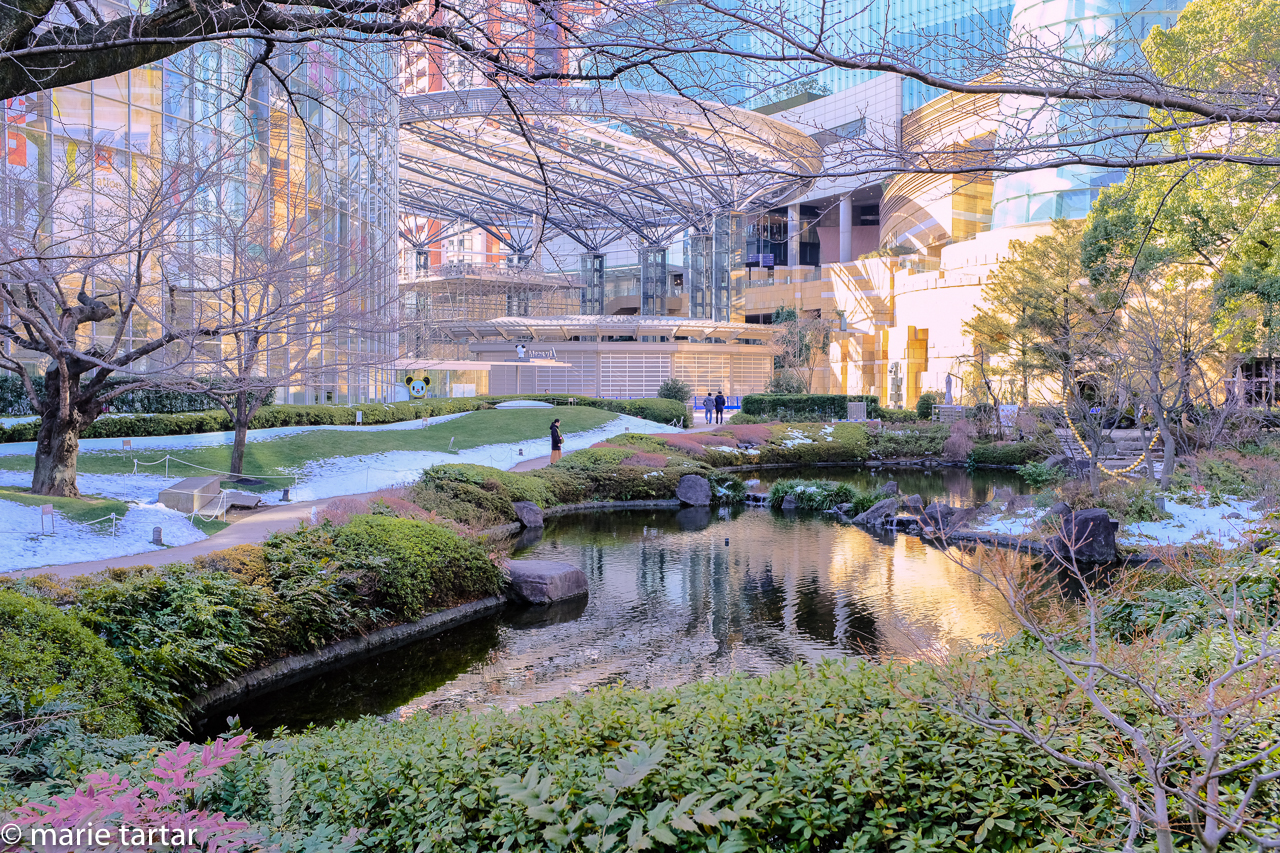
In the neighborhood: Roppongi Hills includes the Mori Tower, which houses the Mori Art Museum. The views from the Sky Deck are amazing! A huge Louise Bourgeois spider sculpture Maman lurks on the ground level.
My Google mapping of our course identified a lunch destination nearby, Ippudo Roppongi, where we enjoyed bite-size gyoza and ramen for lunch. To tide ourselves over en route, we ducked into a Dean and Deluca outpost, sharing exceptionally nice versions of a chocolate and berry muffin, a roasted banana cake and avocado toast.
En route, we ducked into the Fujifilm Square building, with street level galleries, highlighting in the Photo History Museum the black and white folkloric work of Haga Hideo. He was raised in Manchuria and did not experience his native land until the age of 18. The responsiveness of the Japanese to nature and the changing of the seasons, celebrated in matsuri (festivals) was to resonate strongly in his future work. A college professor’s comment that “gods appear …(to) village people in the transitional period between the seasons” led him to try to capture the gods’ presence through photography. There also were 2 shows of the work of younger contemporary photographers, who were present. Ryo Kusumoto presented a show focused on an older traditional Japanese dancer, Fumiko Yamato, as she passes on her knowledge to her students. Kensaku Seki, a former elementary school teacher, presented a body of work focused on a colleague, an expectant father, confronted at the age of 34 with a brain tumor, documenting the diagnosis, surgery, post-operative paralysis and eventual recovery. The photographer stepped up helpfully as I examined a print in which his friend looks at his brain tumor on an MRI.
21_21 Design Sight Museum is a low-rise building, with much of the 2-level structure underground, capped by a giant folded steel roof, a structural riff by Ando on Issey Miyake’s clothing concept, “A Piece of Cloth”.
Despite its title, Wild: The Untamed Mind, we weren’t wild about the show itself, but the building was an attractive, minimalist oasis of calm. The show’s theme seemed a bit of a stretch, a loosely articulated meditation on nature and creativity. The best thing about the show was the poster, featuring an amoeboid creature, a cross between My Mother the Car and a dripping paintbrush.
A short and pleasant walk along Aoyama Cemetery brought us to Omote-Sandō and a cluster of Issey Miyake stores. It was sunny and crisply cold out, with patches of snow persisting from the biggest snowstorm in recent Tokyo history. Just like on our prior trip, we managed to buy enough clothes for Steve to pay with points for a top for me. I was surprised that they were unable to find our account in their computer. It turned out they were inputting our full, passport version names. While I was musing at the register…”Now, where would I have put that card…the smart thing would have been to have stored it with the leftover Yen and the Pasmo cards…” Bingo! I dove into my tote for the envelope, and there it was!
Our dinner that evening was tempura, with Mari and Hideo, a lovely and stylish francophone couple we met in Paris a few years back. Mari had sensibly suggested we met at the “very compact” exit #2 at the Kayabacho station. They made us a present of of our very own okinomiyaki kit, all the ingredients to make our own (minus the egg), in a cute red polka dotted bag. We were to put this to good use the weekend we returned home.
After dinner, we headed down the street for drinks at Wall Street, a comfortable bar with a distinctly French feel (www.soyes.jp).
Tuesday, January 30, 2018
The 3 of us and our bags barely fit into a cab as we made our way to Ginza to drop our luggage off, to hook up that evening with our nature photography group.
I hadn’t liked the look on the Internet of the APA Ginza Kyobashi Hotel enough to book our extra nights there, but it proved to be a well located business hotel, very close to the Kyobashi subway stop. The room was outfitted with all necessities, but was almost comically small once we rolled our 2 elongated duffels on wheels into the room.
Bags safely deposited at the hotel, we found ourselves prowling Ginza at 10 am in search of food, but most restaurants don’t open until 11 am. But the local depaatos (department stores) all have bounteous basement food courts, so into Matsuya we headed, tiding our appetites over with the first of many rice balls (onigiri) we were to consume this trip.
A few last minute gear purchases were made at outdoor store Montbell while waiting for an okinomiyaki restaurant, Tsuruhashi Kitchen in nearby Tokyo Square Garden, to open. Mine was crispy and delicious, negi-yaki, with spring onions. The waiter’s recommendation of Hiroshima style with noodles proved to be a gloppy, poor introduction for Greg to this normally savory sensation.
Over a year before, we were in Tokyo with MOPA, and met Hiroshi Sugimoto, an artist we have followed with interest for decades, at his mesmerizing retrospective at TOP (Tokyo Photographic Art Museum). Afterwards, we visited his gallery in Tokyo, Gallery Koyanagi, in Ginza. I had been corresponding with Asako-san in the gallery, negotiating a purchase from his Lightning Fields series, but had been derailed by the NY co-op purchase. Now, we were only a block away from the gallery and I had a chance to see the work I had selected from books the gallery had sent us, but had never seen in person.
This being a more expensive than usual for us art purchase, Steve had put the brakes on while we were dealing with the apartment transaction. I hadn’t forgotten it and fervently hoped he would be persuaded to move ahead with the acquisition if he saw it in person.
One sticking point in my prior correspondence with Asako-san had been the question of shipping and insurance. At the gallery, she showed us how neatly and effectively they could bundle up the unframed image to hand-carry it on to the plane! Steve was willing, possibly weakened by my persistence. My upcoming birthday was a convenient excuse and thus we went for it. The package would be prepared for us while we traveled around Japan and when we passed back through Tokyo, we would intersect with it…somehow.
From there, we hopped on the Ginza line to Omote-sandō and the Nezu Museum. This gem with a surprisingly large and gorgeous garden is the work of architect Kengo Kuma, described by the New York Times in a recent profile as “the most famous Japanese architect Americans have never heard of”. It is named for and on the site of the family home of Nezu Kaichirō, a businessman whose personal collection of Japanese and Asian pre-modern art and tea ceremony artifacts form the nucleus of the collection. The current structure was commissioned by the grandson of the collector and opened in 2009.
Our friend Gordon, an ardent collector of contemporary Japanese ceramics, was the first to cue us into this jewel. On our prior trip with MOPA in November 2016, we ran into the whole MCASD gang in the lobby, as the late afternoon sun turned the garden into pure gold. Now, the garden was dotted with patches of snow and it was much easier to score a table at the tea house, a glass box looking over the grounds, a lovely spot for the first of many “cakey” breaks we were to take this trip. (Yes, the Japanese for cake really is pronounced cake-y; spelled like kēki, or ケーキ in katakana, used for foreign derived words).
We weren’t meeting up with the group until 7 pm, which left us enough time to go shoot the Shibuya scramble, the world’s busiest (yet orderly) intersection. It is a crazy convergence of humanity, an explosion of neon signs, traffic and pedestrians in a vital stew of modernity.
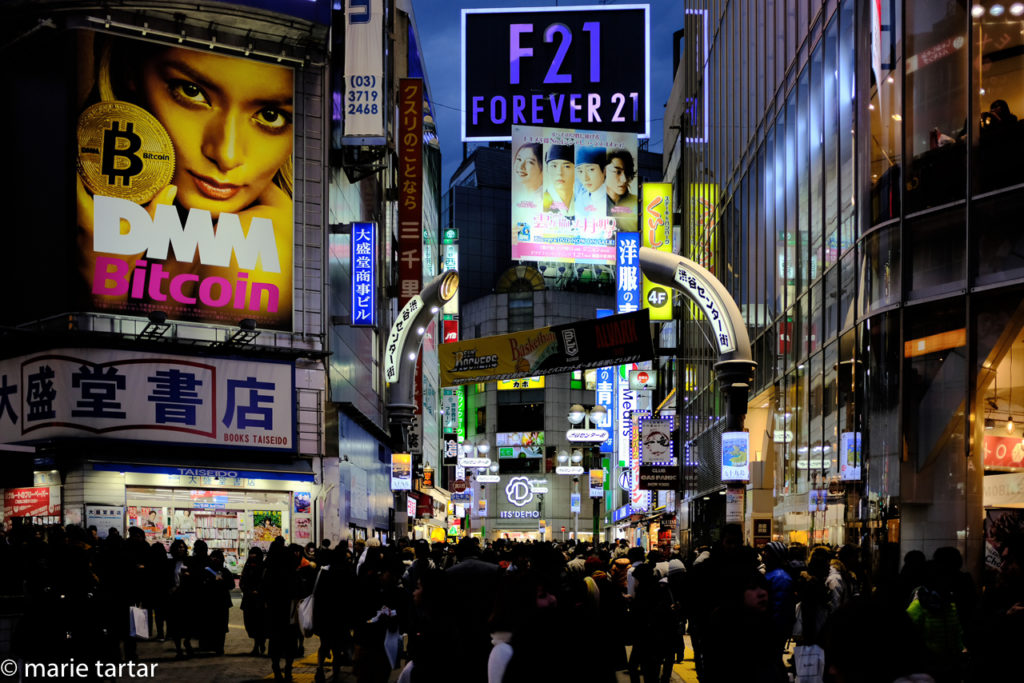
Oh, the humanity! Shinjuku, Tokyo, the busiest convergence of crowds, cars and buses, lit up with a bit of neon signage.
All too quickly, our time to ourselves in Tokyo was over. Our Ultimate Winter in Japan workshop was about to launch and we headed back to Ginza to see what exactly we had signed up for…
-Marie


